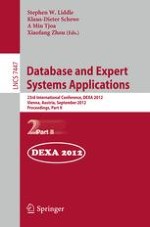This two volume set LNCS 7446 and LNCS 7447 constitutes the refereed proceedings of the 23rd International Conference on Database and Expert Systems Applications, DEXA 2012, held in Vienna, Austria, September 3-6, 2012.
The 49 revised full papers presented together with 37 short papers and 2 keynote talks were carefully reviewed and selected from 179 submissions. These papers discuss a range of topics including: database query processing, in particular XML queries; labelling of XML documents; computational efficiency, data extraction; personalization, preferences, and ranking; security and privacy; database schema evaluation and evolution; semantic Web; privacy and provenance; data mining; data streaming; distributed systems; searching and query answering; structuring, compression and optimization; failure, fault analysis, and uncertainty; predication, extraction, and annotation; ranking and personalisation; database partitioning and performance measurement; recommendation and prediction systems; business processes; social networking.
